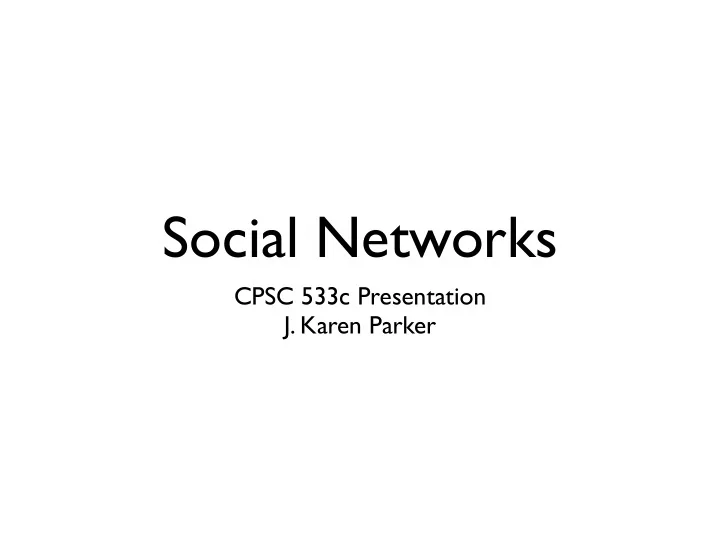

Social Networks CPSC 533c Presentation J. Karen Parker
Social Networks? From Wikipedia: (http://en.wikipedia.org/wiki/Social_network) “A social network is a social structure between actors, mostly individuals or organizations. It indicates the ways in which they are connected through various social familiarities ranging from casual acquaintance to close familial bonds. . . . Social networking also refers to a category of Internet applications to help connect friends, business partners, or other individuals together using a variety of tools.”
Social Networks • Visualizing Social Networks . Linton C. Freeman, Journal of Social Structure, 1, 2000, (1). • Vizster: Visualizing Online Social Networks . Jeffrey Heer and danah boyd. Proc. InfoVis 2005
Social Networks • Visualizing Social Networks . Linton C. Freeman, Journal of Social Structure, 1, 2000, (1). • Vizster: Visualizing Online Social Networks . Jeffrey Heer and danah boyd. Proc. InfoVis 2005
Visualizing Social Networks • Social network researchers have been using visualization for years! • Why? • Provide insight into network structures • Communicate these insights to other • How? • Matrices • Points and lines Visualizing Social Networks (Freeman)
Visualizing Social Networks • Want to uncover two types of patterns: • social groups • social positions Visualizing Social Networks (Freeman)
Point and line displays of social networks Visualizing Social Networks (Freeman)
Hand-Drawn Images in Social Network Analysis • Moreno • graphs • directed graphs • use of colour • varying shape of points • varying location to stress important structural features of data (spatial positioning!) Visualizing Social Networks (Freeman)
Hand-Drawn Images in Social Network Analysis • Lundberg & Steele • “Nuclei” of network as indication of high sociometric status Visualizing Social Networks (Freeman)
Hand-Drawn Images in Social Network Analysis • Northway • target sociogram • target sociogram board Visualizing Social Networks (Freeman)
Point and Line Images Grounded in Computation • Determining locations for points • Factor analysis (Proctor, Bock & Husain) • computed manually • very cumbersome • provided standardized methods - made duplication possible Visualizing Social Networks (Freeman)
Point and Line Images Grounded in Computation • Determining locations for points • Multidimensional scaling (Laumann & Guttman) • computers are now available, so more elaborate computation possible Visualizing Social Networks (Freeman)
Point and Line Images Grounded in Computation • Determining locations for points • Correspondence Analysis (Levine) • tool for locating points in two mode network data (columns and row refer to different objects) • Still no computer-drawn images! Visualizing Social Networks (Freeman)
Computer-Generated Point and Line Images • Several applications developed to output social network data on plotters Visualizing Social Networks (Freeman)
Screen-Oriented Point and Line Images • Finally! Displaying images on monitors! • Personal computers becoming more common • Many applications for displaying/exploring social network data, though some need special hardware (SGI) Visualizing Social Networks (Freeman)
Network Images in the Era of Web Browsers • Researchers displaying/sharing social networks on the web (NOT Friendster) • Early efforts use Java and VRML Visualizing Social Networks (Freeman)
Summary • Presents an interesting history of social network visualization • Movement from ad hoc image drawing to standardized computerized procedures • Social network researchers recognized the importance of visualization long before it became a hot topic Visualizing Social Networks (Freeman)
Summary • Pros • Gives a good overview of the topic • Ideas are presented logically and clearly • Cons • Slightly dated (2000) - What is happening in the field now? Visualizing Social Networks (Freeman)
Social Networks • Visualizing Social Networks . Linton C. Freeman, Journal of Social Structure, 1, 2000, (1). • Vizster: Visualizing Online Social Networks . Jeffrey Heer and danah boyd. Proc. InfoVis 2005
Visualizing Online Social Networks • Online social networks are cool! • Let’s visualize them! Vizster: Visualizing Social Networks (Heer & boyd)
Articulated Online Social Networks • Started to explode around 2003 (Friendster, Tribe, Orkut, etc.) • People use them for social exploration and play Vizster: Visualizing Social Networks (Heer & boyd)
Why Visualize Online Social Networks? • Sometime difficult to understand the network beyond your “friends” • Want to facilitate discovery and increased awareness • Must include profile data as it helps users get a sense of each person Vizster: Visualizing Social Networks (Heer & boyd)
Vizster • video demo Vizster: Visualizing Social Networks (Heer & boyd)
Vizster • Spring-embedding algorithm • Exploration via: • connectivity highlighting • linkage views • search • x-ray mode • community structures Vizster: Visualizing Social Networks (Heer & boyd)
Vizster • software demo Vizster: Visualizing Social Networks (Heer & boyd)
Vizster “User Study” • Observed use in large party situation (terminal + projection on wall) and in small group in lab • Found to be both useful and conducive to social interaction (playing “games” to find people, exploring together) • “Friendster gives you two hours of fun, this doubles it” Vizster: Visualizing Social Networks (Heer & boyd)
Summary • Pros • Employs established InfoVis methods (highlighting, pan & zoom, colour, etc.) to help users explore social networks • Can help users more easily find information about the network • It looks cool! Vizster: Visualizing Social Networks (Heer & boyd)
Summary • Cons • Currently, have to mine data ahead from time • How much time will people really spend using this? • Who really uses Friendster anyhow? Is the “cool” factor enough, or do we want real world applications? Vizster: Visualizing Social Networks (Heer & boyd)
Social Networks • Visualizing Social Networks . Linton C. Freeman, Journal of Social Structure, 1, 2000, (1). • Vizster: Visualizing Online Social Networks . Jeffrey Heer and danah boyd. Proc. InfoVis 2005
Recommend
More recommend